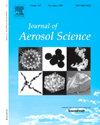北极地区季节性化学成分变化对气溶胶吸湿性的影响
IF 2.9
3区 环境科学与生态学
Q2 ENGINEERING, CHEMICAL
引用次数: 0
摘要
本研究利用北极斯瓦尔巴群岛齐柏林天文台2007年4月至2013年3月6年间的气溶胶微物理观测资料(气溶胶微物理观测资料)对气溶胶吸湿性参数进行了量化,并将其与气溶胶化学成分进行了相关性分析。月平均κphy值呈现明显的季节变化特征,冬春季较高,夏季最低,秋季增加,冬季保持较高水平。为了验证κphy的可靠性,我们采用了化学成分数据(κchem)计算的吸湿参数。计算κchem所需的化学成分和PM2.5质量浓度是通过《现代研究与应用回顾分析》第2版(MERRA-2)再分析数据获得的,κchem的计算假设北极气溶胶只有五种:黑碳(BC)、有机质(OM)、硫酸铵(AS)、直径小于2.5 μm的海盐气溶胶(SSA2.5)和直径小于2.5 μm的粉尘气溶胶(Dust2.5)。与κphy相比,κchem没有明显的相关性,但具有相似的季节性趋势。由于MERRA-2再分析数据中SSA2.5质量浓度占比较大,κchem值与SSA2.5的变化趋势一致,比κphy值平均高1.6±0.3倍。这可能是由于MERRA-2再分析中对海盐气溶胶的高估所致。分析了月平均κ物理与用于计算κ化学的化学成分之间的关系。10 - 2月的大气环流主要受SSA2.5的影响,而3月的最大大气环流主要受北极雾霾期中纬度地区长距离输送引起的AS和Dust2.5的增加以及原位采样得到的SSA质量浓度的影响。4 - 9月相对较低的κphy可归因于低SSA2.5和北极夏季有机化合物的优势。无论是海洋和陆地生物源等自然来源,还是远程输送的气溶胶,都可能导致夏季有机气溶胶的增加,从而潜在地影响大气气溶胶的减少。据我们所知,这是第一个分析利用长期微物理数据计算的气溶胶吸湿性的月和季节变化的研究,这一结果提供了证据,表明吸湿性的月和季节变化取决于化学成分。本文章由计算机程序翻译,如有差异,请以英文原文为准。
Aerosol hygroscopicity influenced by seasonal chemical composition variations in the Arctic region
In this study, we quantified aerosol hygroscopicity parameter using aerosol microphysical observation data (κphy), analyzing monthly and seasonal trends in κphy by correlating it with aerosol chemical composition over 6 years from April 2007 to March 2013 at the Zeppelin Observatory in Svalbard, Arctic region. The monthly mean κphy value exhibited distinct seasonal variations, remaining high from winter to spring, reaching its minimum in summer, followed by an increase in fall, and maintaining elevated levels in winter. To verify the reliability of κphy, we employed the hygroscopicity parameter calculated from chemical composition data (κchem). The chemical composition and PM2.5 mass concentration required to calculate κchem was obtained through Modern-Era Retrospective Analysis for Research and Applications, version 2 (MERRA-2) reanalysis data and the calculation of κchem assumed that Arctic aerosols comprise only five species: black carbon (BC), organic matter (OM), ammonium sulfate (AS), sea salt aerosol less than a diameter of 2.5 μm (SSA2.5), and dust aerosol less than a diameter of 2.5 μm (Dust2.5). The κchem had no distinct correlation but had a similar seasonal trend compared to κphy. The κchem value followed a trend of SSA2.5 and was much higher by a factor of 1.6 ± 0.3 than κphy on average, due to a large proportion of SSA2.5 mass concentration in MERRA-2 reanalysis data. This may be due to the overestimation of sea salt aerosols in MERRA-2 reanalysis. The relationship between monthly mean κphy and the chemical composition used to calculate κchem was also analyzed. The elevated κphy from October to February resulted from the dominant influence of SSA2.5, while the maximum κphy in March was concurrently influenced by increasing AS and Dust2.5 associated with long-range transport from mid-latitude regions during Arctic haze periods and by SSA mass concentration obtained from in-situ sampling, which remained high from the preceding winter. The relatively low κphy from April to September can be attributed to low SSA2.5 and the dominance of organic compounds in the Arctic summer. Either natural sources such as those of marine and terrestrial biogenic origin or long-range-transported aerosols may contribute to the increase in organic aerosols in summer, potentially influencing the reduction in κphy of atmospheric aerosols. To our knowledge, this is the first study to analyze the monthly and seasonal variation of aerosol hygroscopicity calculated using long-term microphysical data, and this result provides evidence that changes in monthly and seasonal hygroscopicity variation occur depending on chemical composition.
求助全文
通过发布文献求助,成功后即可免费获取论文全文。
去求助
来源期刊

Journal of Aerosol Science
环境科学-工程:化工
CiteScore
8.80
自引率
8.90%
发文量
127
审稿时长
35 days
期刊介绍:
Founded in 1970, the Journal of Aerosol Science considers itself the prime vehicle for the publication of original work as well as reviews related to fundamental and applied aerosol research, as well as aerosol instrumentation. Its content is directed at scientists working in engineering disciplines, as well as physics, chemistry, and environmental sciences.
The editors welcome submissions of papers describing recent experimental, numerical, and theoretical research related to the following topics:
1. Fundamental Aerosol Science.
2. Applied Aerosol Science.
3. Instrumentation & Measurement Methods.
 求助内容:
求助内容: 应助结果提醒方式:
应助结果提醒方式:


